4. FARM FEATURES
Description Wildlife Interest
Hedges are important landscape features, they delineate field and farm boundaries and are a haven for wildlife. Plant diversity is created by the species which make up the hedge itself and the many species which grow at the hedge bottom. A vast array of insects, birds and mammals use the hedge as a source of food and cover. One of their most important roles is that of a wildlife corridor, enabling many species to move throughout their range to find food sources, territories and mates during the breeding season. Isolated hedgerow trees allow birds to define territories and provide nest sites. The field margins at Horseley are dominated by drystone dykes and therefore hedges do not figure much in the landscape at present. A small section of hedge remains by the trackside to the south of the steading and the march above the Dreich Plantation has the remnants of an old hedge in place. These two existing stretches of hedge would benefit by being gapped up/replanted and there are further opportunities on the farm for creating new hedges which will enhance the wildlife corridor effect across the farm.
Management/Recommendations
- Gap up the existing hedge leading south west from the steading. In large gaps replace with Hawthorn hedging; in small gaps of about 1m, replace with hedgerow trees.
- Replant the old hedge above the Dreich Plantation. Erect new fences either side to protect from stock. Either rabbit net new fences or protect plants individually by means of spiral guards. Coppice the old stems to approximately 4" high to allow them to re-grow with the new hedge plants.
- Establish new hedges as shown on the management map, alongside existing fencelines. In addition to their benefit for wildlife and biodiversity, they will, in most instances, provide shelter for stock.
Description/Wildlife Interest
Woodland is not only an attractive addition to the landscape, it is also one of the most important features in terms of wildlife. They offer a relatively stable environment compared to the other areas of the farm which are cultivated or grazed. Even a small wood can offer a variety of habitats; woodland edge, canopy, shade and undergrowth. Old woods and those which are composed of native species are the most important in terms of biodiversity.
A small component of semi-natural woodland persists in Brockholes Dean; such woodland is now a relatively rare commodity and is particularly important in terms of biodiversity. Species composition is a variety of Pedunculate Oak, Hazel, Alder, Rowan, Hawthorn and Blackthorn and together they create a habitat which supports a high number of insects and bird life. Their composition of native species is especially valuable as these trees have more associations with indigenous fauna and therefore contribute more in wildlife terms than introduced species.
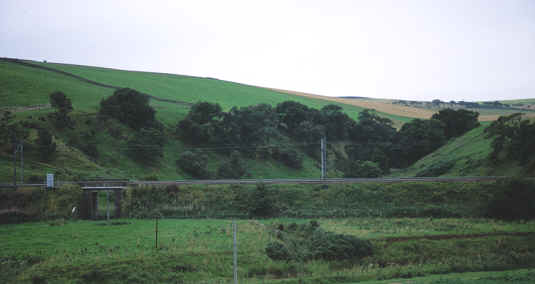
Brockholes Dean viewed from the A1
Elsewhere on the farm a number of conifer shelterbelts have been planted over the last 20 years. More recently, mixed woodlands have been established which punctuate the landscape and offer 'islands' of habitat across the farm. Together they contribute an important source of habitat and again, where native species have been used, they contribute more to the wildlife on the farm. The younger, mixed woodlands are well established and are beginning to enhance the landscape value of the farm. At some point, decisions will have to be made regarding the conifer blocks and how to manage them. Thinning may make them vulnerable to wind-blow in such an exposed location and economic factors will also influence this. If left un-thinned, the individual stems become tall and thin and difficult to withstand the forces of the wind. Unfortunately, there is no easy answer and the economics often mean that returns are unfavourable. If they are left and ultimately clear-felled it would be beneficial to replace with a mixture of species which will be more valuable to wildlife and enhance the landscape value of the farm. Broadleaves also command higher rates of grant under the Woodland Grant scheme. Any such decisions on the younger plantations are some way off, but the older stand of Lodgepole pine to the south east of the steading has suffered a large amount of wind-blow and is in need of attention. The remaining stems are now more exposed and the wind-blow is just likely to continue. Any activity will of course require some sort of financial outlay however and the low quality of the timber is unlikely to realise much in terms of income.
A small planting has been establish by the Scottish Wildlife Trust as part of an A1 corridor enhancement project.
Management/Recommendations
- Future management of conifer plantations may involve clear-felling and replanting with native broadleaves. A shrub component would also be beneficial to establish an under-storey and a diversity of cover.
- Higher value species such as oak will benefit from pruning to improve form and maximise returns from timber although at some considerable time in the future.
- Clear-fell the blown Lodgepole plantation and replant with native broadleaves. To spread costs, this could be done in 2 or even 3 sections although it would be simpler to include under one WGS application.
- Enhance the field margins around the steading by planting further individual trees along the dyke-back such as those already established. Roots are likely to affect the stone work over time and alternatively, trees could be established within the field and protected by paling rail.
- If the small burn below the steading was fenced off, the ground between the burn and the dyke could either be left accessible to stock, or perhaps be planted with native broadleaves.
Description/Wildlife Interest
All fields contain some sort of margin, whether it's a dyke-back, fenceline or burn-side. These also form wildlife corridors although less obvious. Established perennial plants growing in the margins don't generally invade the crop and prevent colonisation by pernicious weeds. Tussocky grasses form the ideal over-wintering site for many insects and ground nesting birds like the Grey Partridge can rear their young where the cover is dense enough. Many of the insects which inhabit field margins are predatory and offer benefits to controlling injurious pests in arable crops.
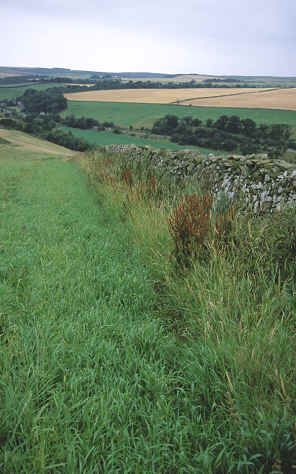
Because dykes can be made unstable by cultivating too close, there are numerous small grass margins throughout the farm following the dyke back. Whilst they do not perhaps offer as much for wildlife as hedged margins, they are none-the-less important in providing corridors and cover for birds, mammals and insects.
Fertiliser application into the field margin is avoided by adjusting the spreader; the margins along the dyke or fence can be more diverse if fertiliser application can be avoided. Wild flowers prefer nutrient poor areas but pernicious weeds can thrive in uncropped areas which receive fertiliser applications.
Management/Recommendations
- Maintain the existing uncultivated margins along the dyke-back.
- Consider establishing wider grass margins/beetlebanks under a scheme such as the RSS. Such margins can also negate the need for LERAP's¨ in arable situations by buffering the water course.
- Scare wires erected back from the dykes would allow small un-grazed margins to establish along the field edge.
- By not spraying the headland with herbicide and insecticide arable weeds can persist which provide a nectar and food source for insects, these insects constitute a protein source which is vital to young game bird chicks during their early life. Such conservation headlands are also prescribed under agri-environment schemes as well as conservation grade grain production.
Ponds, wetlands and watercourses
Description/Wildlife Interest
It is estimated that land drainage has taken place in Britain for some 2000 years, and during this time a huge area of wetland has been lost. Those sites which remain are obviously at a premium, especially as they offer so much in terms of biodiversity. A vast array of wildlife relies on such wetland areas for food and habitat. Similarly, watercourses act as wildlife corridors for many species particularly when they have intact bankside vegetation. BAP species such as Water Voles and Otters rely on such corridors for habitat and the ability to move from one area to another.
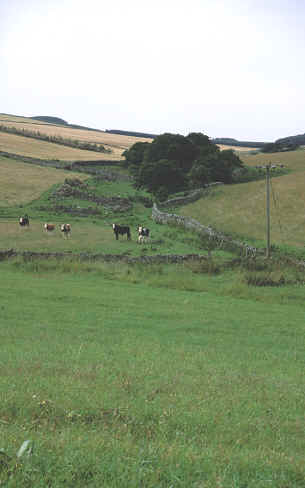
The Brockholes Burn forms much of the northern march of the farm. Through the arable fields and the Brockholes Dean, it's margins are well vegetated and offer cover for species such as Water Voles and Otters. It forms a more or less intact corridor from the conifer plantations at the north west corner of the farm down to the semi-natural woodland in the north east corner and links the Eye Water and the Whiteadder, a major tributary of the Tweed.
The small watercourse which rises on the west of the farm and flows down towards the steading had formerly supplied the mill pond but has recently had it's course altered to meet the Brockholes Burn more directly. The Mill Pond itself is now overgrown and dried out. Re-instatement would be a great enhancement to the wildlife value of the farm. The other small watercourse which emanates from a spring to the east of the farm cottages, makes it's way to the Eye Water. Obviously when the associated fields are in arable crops, the bankside vegetation is allowed to flourish whilst at times when the fields are in grass, they are open to grazing. Fencing to prevent grazing would create healthy margins which are consistent. (Obviously, when fencing off watercourses, drinking access must be allowed for.) The banks of the Eye Water are dominated by Alder and Willow and associated riparian vegetation. The banks would benefit from being protected from grazing.
Management/Recommendations
- Fence off water margins to prevent grazing by stock. This allows vegetation to develop and forms a natural riparian corridor which benefits species such as Water Voles. Obviously, when the fields are in crop, the margins flourish and if this could be maintained during grazing, the benefits would be continuous.
- Establish a small number of waterside trees to provide shade and cover.
- Create a generous margin on the Eye Water with a new fence.
- Investigate the possibility of re-instating the farm pond. Dig out the in-fill and remove/coppice some of the surrounding trees to let light in.
- Consider establishing new pond and/or wetland area by Brockholes Burn. (NB. Under agri-environment schemes, watercourses must be a minimum of 60cm bed-width to qualify for management.)
Description/Wildlife Interest
Set-aside can offer much in the way of benefits to wildlife. Much depends on the way the set-aside is managed but it is especially good for insects and birds. The set-aside areas are relatively undisturbed and their existence throughout the winter months is especially beneficial when the birds have access to fallen seeds and soil- borne insects.
Approximately 35ha of rotational set-aside is established annually. Grass is sown to establish a green cover and this is topped. Pernicious weeds are sprayed to prevent their spread.
Management/Recommendations
- Consider sowing wild bird cover on at least a small area of set-aside (see notes later in this plan).
- Up to 25% of set-aside can be left un-cut; likewise, a 2m strip adjacent to a wood or hedge.
- If the green cover is dense, cut from the centre outwards so that ground dwelling birds can escape.
- Avoid cutting in April-mid July during nesting season.
- Vary the height of cut to create a variety of cover.
Species rich/Unimproved grassland
Description/Wildlife Interest
Unimproved areas of grassland are at a premium; they usually occupy sites which are difficult to manage and have therefore avoided much disturbance over the years. Wild flowers need a nutrient-poor soil and therefore only occupy sites which have avoided inputs of fertiliser over the years. Such assemblages of wild flowers support large populations of insects and enhance the diversity of the farm.
A small area of steep ground adjoining Brockholes Dean has avoided cultivation and fertiliser due to it's difficult nature and therefore supports quite a diversity of wild flowers, such as; knapweed, meadow vetchling, ribwort plantain, germander speedwell, eyebright, birdsfoot trefoil, field mouse-ear, red campion and hawkbit.
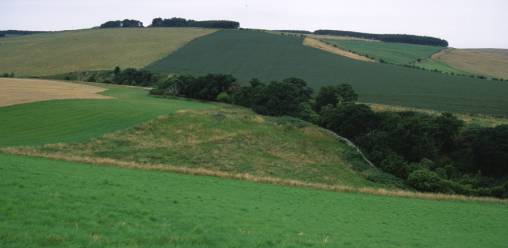
Area of species-rich grassland by Brockholes Dean
Management/Recommendations
- Species rich areas rely on seasonal grazing to prevent domination by coarser species. Access by grazing livestock under the present rotation seems to be adequate to maintain species diversity although it is normally required annually, after the flowers have set seed. Ideally, when the field is grazed, the species rich element should only be grazed later in the year ie In August, but this could only be controlled by fencing and limiting stock access.
- Maintain a buffer around the site from fertiliser and chemicals.
- Resist the temptation to plant the area with trees as the open nature of the grassland is important.
- Prevent bracken from encroaching out of the Dean.
Description/Wildlife Interest
At first site, dykes would not appear to offer much in terms of wildlife value. However, in addition to their prominence as a landscape feature, they still have some effect as a wildlife corridor particularly in cultivated fields where they have an associated grassy margin. Dykes have important associations with many lichens and mosses; they provide habitat for many invertebrates and the spaces between stones can be used by nesting birds such as the Wheatear. Small mammals such as Stoats and Weasels will also use the dykes for cover.
The network of dykes at Horseley is extensive and in good condition, thanks to a policy of on-going repairs.
Management/Recommendations
- Maintain dykes in present good condition.
Description/Wildlife Interest
The extensive area of spring barley means that stubbles are left for long periods over-winter. This leaves cover for ground dwelling birds and because the soil is not disturbed by autumn ploughing, there are numerous soil-borne insects which are left available to foraging birds during the hard winter months.
During the field work for this plan, the field of fodder rape was awash with numerous species of butterflies and bees feeding on the nectar supplied by the plants. (such as the Peacock butterfly shown here). Additionally, the sort of cover afforded by fodder rape, kale etc is suited to ground dwelling birds such as Partridges.
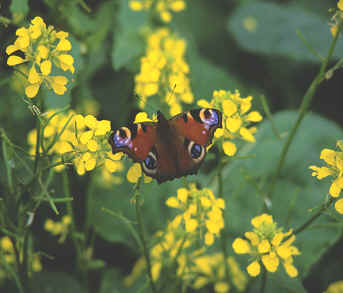
It is quite often the case that there are areas on farms which are perhaps difficult to work eg from being too wet or too steep. Similarly, other areas might fail to yield on an economic level for similar reasons or perhaps due to soil conditions. It is quite possible that these areas are actually costing the business money and although they are not very significant, they may be better employed by another means. This could entail removing the areas from cultivation and perhaps creating an area of wild bird cover which could enhance the farm shoot and the general habitat, or, establishing multi-annual set-aside, or, exploring some of the options under schemes such as the RSS which cover establishing new meadows, wetlands and unharvested crops. These have the additional benefit of providing an annual management payment to those who are successful in entering the scheme.
Management/Recommendations
- As long as farm business decisions allow; maintain the use of spring cereals and a rotation involving root crops.
Description/Wildlife Interest
A small syndicate shoots the ground on a relatively informal basis. Pheasants have been released in the past but not this year. Feeders are set up in a number of the woods to support game over the season. Two covey's of Grey's have been seen this year but in small numbers and less frequently than in years gone by. The fox population is noticeably high and the number of Lapwings has declined noticeably in recent years.

Twin Roe Deer fawns in Barley field.
Management/Recommendations
- Set up feeders to be accessed by partridges; using smaller grains such as wheat tailings if possible.
- Continue feeding into the nesting season so that adult birds are in better condition.
- Predator control should be considered. Foxes, weasels and stoats can all have detrimental effects on both game and wild bird populations. Trap lines can be conveniently located so as to minimise inspection times. Corvids can also be problematic during lambing so their control is especially beneficial.
- Awkward field corners might be candidates for establishing game cover or for example the 'unharvested crops' option in the RSS.
Archaeological sites offer valuable insights into the borders Landscape of the past. When archaeological sites are know to exist or are obvious on the ground, they should be protected from potentially damaging operations. There are no obvious signs of significant archaeology at Horseley, however during times of particularly dry weather, crop marks can be seen below the Lodgepole plantation. Further information would be available on request from the District Archaeologist at Scottish Borders Council.